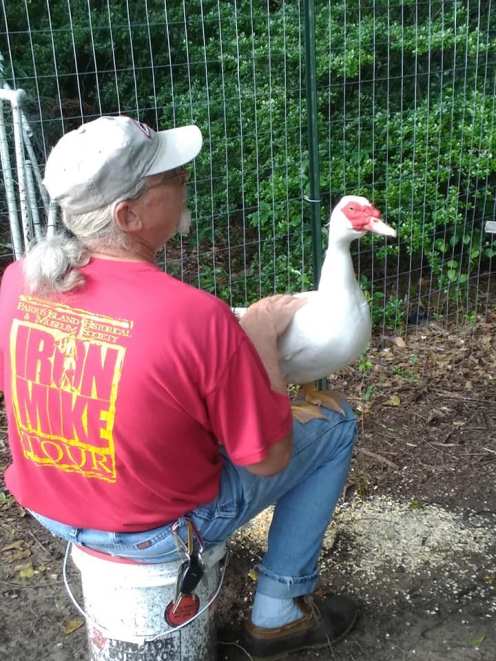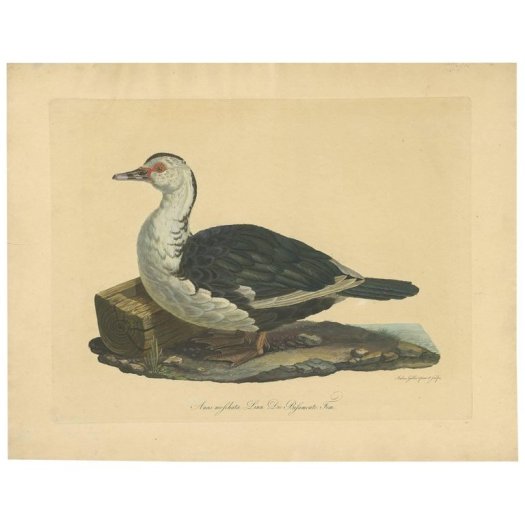Those unfamiliar with Muscovys may refer to my previous article.

Our Muscovy drake, Ralph, approximately 1 1/2 years old.
Muscovy flesh was noted to be excellent in flavor. Dixon wrote that the flavor was excellent if killed just before fully fledged [having wing feathers sufficient enough to enable the bird to fly], but it took longer in achieving growth for the table than the common duck. “The flesh is at first high flavoured and tender, but an old bird would be rank and the toughest of tough meat.”
Most potential poultry growers eventually get down to brass tacks and ask about the meat harvested from this breed. Muscovy meat is thinner-skinned, less fat, and deep red, often compared to beef in flavor and tender. A Muscovy carcass is heavy for its size and the breast is larger than a Pekin. Muscovy eggs are rich in flavor and excellent for baking.

- T. G. Carey, a Muscovy breeder in Australia said of his “aquatic fowl” they have more flesh upon their body than any other poultry. “. . . learn how to relish the juicy Muscovy duck-meat with green peas, and the trial must convince him or her how remunerative this proposition [raising Muscovys] may prove.” –
Robert Schomburg pronounced wild Muscovy flesh, “excellent eating”. –
- W. Summers likewise noted that Muscovy were, “the best table fowl of any of the water-fowl variety”.
Marguerite N. de Freltas replied to a previously published comment in “Pacific Poultry Craft” advising that anyone reporting on fowl should have kept them long enough to know their habits and worthiness before submitting information to magazines and disagreed wholeheartedly with the writer of the previous article. “. . . we eat the drakes at two years and consider them very fine—they are not ‘hard, dry nor rank’. On the contrary, the family all decided that the last one we ate was better than the previous one of seven months. . . I can cook one of my birds at two years, and . . . it will be very good to eat”. Dec. 1914.
Recipes specifying Muscovy are rare, probably because, as Todd Goodholme noted, Muscovy was among the various breeds, “which are very fine for the table” and as such any of the better breeds was suitable for preparation. After all, chicken recipes do not specify a particular breed. His recipes were noted suitable for any type of duck.
William Gibson likewise discussed Muscovys, and, under that heading, we find in his index, “To cook [a Muscovy].—See Duck”.
The following recipe from “Good Housekeeping” did specify using a Muscovy.
“The best duck for ordinary occasions when such luxuries as canvas back, red head, and teal are not to be thought of is a young Muscovy drake. Choose a fat tender one; there is too little meat on a duck for it to be worthwhile to take the trouble to cook a tough stringy one. Rub it well inside and outside, first with plenty of fine salt and black pepper, then give it a second rubbing with finely pounded sage, marjoram, and savory all equal quantities, pounded together, and sifted free of stalk and stem. Always add a dash of cayenne inside and out to any meat or game that is being seasoned. Make a stuffing of bread crumbs (either corn or wheat bread as preferred, that is a matter of taste. . .) about a pint, or more, according to the size of the duck in a bowl with a teaspoonful of powdered sage, marjoram, savory and black pepper, a small onion minced, or grated, which is better, two tablespoons of fresh butter, and enough sweet cream to moisten it into as soft a mass as can be handled. . . Stuff the duck well and sew it up, dredge it with flour and put it in a pan with half a pint of water, and half a pint of red wine, have the oven very hot, so the duck will cook quickly and be a rich brown when only about half done, for ducks are eaten quite half raw! Baste it well with flour and butter on a larding mop, and pour over it from time to time the liquid in the pan. When the ducks are taken up if the gravy is not thick enough add a little flour and sage rubbed together and allow it to come to a boil, then add a wine-glass full of walnut or mushroom catsup, a spoonful of sugar or currant jelly, the juice of half a lemon, a good dash of red pepper, and serve very hot.”
STEWED WITH GREEN PEAS. [Goodholme] Half roast the duck; skin it, and put it into a stew-pan with a pint of beef gravy [stock], a few leaves of mint and sage cut small, pepper and salt, and half an onion shred as fine as possible. Simmer a quarter of an hour, and skim clean; then add about a quart of green peas. Cover tightly and simmer about half an hour longer. Add a tablespoonful of butter and as much flour, and give it one boil and remove from fire; serve with the peas around it on the dish.
DUCK RAGOUT. 1866. Half roast a duck, then score the breast in three places at each side, lightly strew mixed spices and cayenne into each cut, and squeeze lemon juice over the spices. Stew the bird till tender in good brown gravy; take it out and keep it hot; add one or two finely-shred shallots to the gravy, also a glass of red wine, and pour the gravy over the duck.
ROAST MUSCOVY DUCK. 1919. (Served with apple sauce). Clean a Muscovy duck, season with salt and pepper, and stuff with a piece of celery and two shallots chopped very fine. Put the duck in a roasting pan with a sliced onion and carrot, add a little water, and put in a hot oven. The water will evaporate quickly, and the fat from the duck will be sufficient to roast it. Baste often. When done place the duck on a platter, remove the fat from the pan, add one cup of stock and a spoonful of meat extract, boil for five minutes, and pour over the duck.
TO DRESS A DUCK WITH JUICE OF ORANGE. 1723. Roast the Duck, till it is half enough; then take it up, lay it in a Dish, and cut it up so as to leave all the Joints hanging to one another. Then take Salt and Pepper pounded, and put between every incision; also, squeeze in some Juice of Orange. Then lay the Duck in a Dish upon the breast, and press it hard down with a plate; set it over the Stove for a little time; then turn the Breast upwards again, and serve it hot in its own Gravy.
Should your experience with Muscovys resemble ours, you will have quiet but friendly companions and their offspring should furnish your table with fine dining. As always, Blissful Meals.
See: – “The Cook’s and Confectioner’s Dictionary. . .”. London. 1723. – Hirtzler, Victor. “The Hotel St. Francis Cook Book”. Chicago. 1919. – Philip, Robert Kemp. “The Dictionary of Daily Wants”. London. 1866. – “Good Housekeeping”. Feb. 1890. – “Camp Life in the Woods and the Tricks of Trapping and Trap Making”. 1881. – Goodholme, Todd S. “Goodholme’s Domestic Cyclopaedia of Practical Information”. New York. 1889. – “Ducks and Geese”. Published by Reliable Poultry Journal Publishing Company. 1904. Schomberg, Robert. “Report of the Third Expedition into the Interior of Guayana”. 1837. Queensland Agricultural Journal”. May 1920. – Brown, Edward. “Races of Domestic Poultry”. 1906.
© May not be reproduced without the permission of the author.

You must be logged in to post a comment.